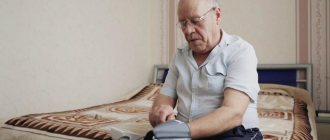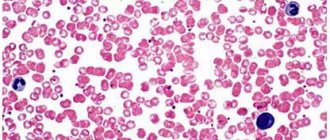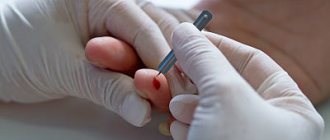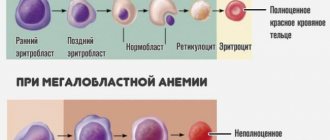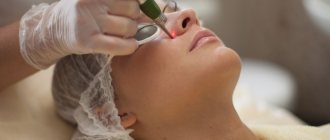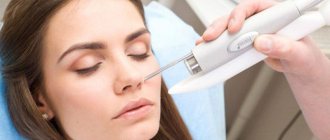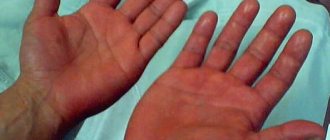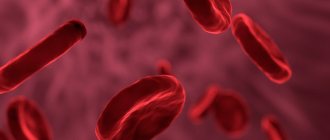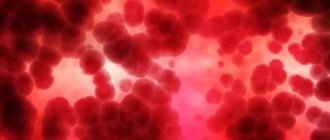Main manifestations of wounds
Pain
In this case, pain occurs due to damage to the nerve endings that were located at the site of the injury. Over time, swelling may increase, which also leads to increased pain. The severity and degree of manifestation of pain depends on factors such as:
- location of the defect, concomitant damage to large nerve trunks;
- type of weapon or conditions of damage (asphalt, garden, bicycle, sharp object, etc.);
- psychological state of the child.
In essence, pain is an adaptive defense reaction of the body.
Bleeding
Any damage to the skin or mucous membranes is in one way or another accompanied by damage to blood vessels (capillaries, arteries, veins). The nature and degree of bleeding depends on the type of damaged vessel. The larger the vessel and the higher the pressure in it, the more massive the bleeding, and vice versa. It is worth highlighting those places on the body that are accompanied by more heavy bleeding: face, head, neck, hands . In these places, the tissues are better supplied with blood. The condition of the blood coagulation system plays an important role. If a child has a minor abrasion or scratch, which is accompanied by prolonged and heavy bleeding, then it is necessary to consult a pediatrician and pediatric hematologist in order to exclude a disease of the blood coagulation system. This may also be indicated by the appearance of a large number of bruises for no reason.
If a small abrasion is accompanied by prolonged and heavy bleeding, then it is necessary to consult a hematologist.
Hiatus
This phenomenon is associated with a reduction in the elastic fibers of the skin. As a result, the skin edges of the lesion diverge. Many surgeons know what Langer's lines are. They indicate the course and direction of the fibrous structures of the skin. For this purpose, incisions are made along these lines, which leads to rapid healing of the incisions and reduction of gaping. Accordingly, when a defect appears perpendicular to these lines, a wide divergence of the edges of the defect develops.
Consequences and complications
If first aid is provided incorrectly due to a cut finger, the following complications may develop:
- Numbness is a consequence of nerve damage.
- Infection – leads to the development of purulent infection. In this case, cleaning the wound and using antibiotics .
- Tetanus is an acute infectious bacterial disease. The causative agent is a gram-positive tetanus bacillus. The nervous system is affected, and there is a high risk of mortality (about 50%). It can develop if a person has not been vaccinated in a timely manner.
Types of wounds
They can be:
- Operating: applied deliberately for the purpose of performing an operation.
- Accidental: as a rule, these are household damages.
Depending on the nature and conditions of the damage, wounds are distinguished:
- chopped;
- I stab;
- bruised;
- torn;
- crushed;
- chopped;
- bitten;
- mixed;
- firearms.
In children , cut, puncture, bitten, mixed, and also superficial (abrasions, scratches, etc.) predominate. Particular attention is paid to bites that result from an animal or human bite (for example, another child), as they are the most infected. This is due to the large number of harmful bacteria in the oral cavity. They are most often complicated by infection.
According to the degree of infection there are:
- Freshly infected. As a rule, this damage occurs within 3 days from the date of its application. Defects with soil contamination are especially infected.
- Purulent. An infectious process develops in these lesions. Microbes, when multiplying, lead to increased inflammation, necrosis, and also contribute to the appearance of pus. Children with purulent manifestations develop symptoms of general intoxication: nausea, headache, dizziness, weakness, lethargy.
Diet
Diet for anemia
- Efficacy: no data
- Time frame: 3 months
- Cost of products: 2700-3200 rubles. in Week
You need to eat rationally and fully. At the same time, the diet should contain foods containing large amounts of collagen and other substances that promote wound healing. It is recommended to consume the following products:
- Vegetables, legumes - beans, peas, carrots, sweet peppers, green leafy vegetables.
- Fruits - citrus fruits, apples, pears, berries, bananas.
- Nuts – almonds, walnuts.
- Lean meat - turkey, chicken breast.
- Ginger.
- Seafood, sea fish.
- Oatmeal.
It is also important to drink enough fluid to activate metabolic processes.
Wound healing and factors influencing this process
The wound healing process can be disrupted by many factors.
Healing is the process of repairing damaged tissue and restoring its integrity. During the healing process, certain processes occur. We will not dwell on them in more detail, but will only indicate those factors that may disrupt the healing process:
- Age. As a rule, this applies more to older people. The child's body has great regenerative capabilities. This is due to the high level of anabolic (construction) processes in the body.
- Attachment of infection.
- Decreased immunity.
- Poor circulation in the wound area.
- Chronic diseases (diseases of the respiratory and cardiovascular systems, diabetes, tumors and others).
Healing complications
- Attachment of infection . Most often, a nonspecific purulent infection develops. The threat is tetanus, rabies, diphtheria. Therefore, injuries that have been bitten and contaminated with soil or old metal objects should be immediately examined by a surgeon with a number of preventive measures taken (administration of anti-tetanus serum, rabies vaccine).
- Bleeding.
- Divergence of defect edges.
- In some cases, healing may be complicated by a hypertrophic scar or keloid . They are an abnormal scar that can spread beyond the defect area and also contribute to the development of complications.
Treatment with folk remedies
There are many folk remedies that can be used as aids in the treatment of cuts. Their use is especially relevant in situations where trouble occurs outside the home, or when appropriate medications are not available.
- Aloe juice – promotes wound healing. It is necessary to squeeze the juice out of an aloe leaf, blot a napkin and apply it to the wound.
- Strawberry leaves - help cleanse an infected wound. They need to be washed and steamed, and then applied to the damaged area.
- Dry black tea – you need to grind it and sprinkle it on the surface of the wound. This remedy is effective for minor injuries.
- Ash bark - apply it to the cuts with the juicy side and fix it. Change the product 2-3 times a day.
- Plantain leaf - crush fresh leaves, apply to the wound and secure with a bandage. The product should be changed every two hours.
- A decoction of rose hips - a compress from it is applied to the wound.
- Nettle tincture – tincture is prepared from fresh nettle leaves. They should fill a glass container and fill it to the top with alcohol. After two weeks, the tincture can be used. Apply a compress with the product to the washed wound.
Products for treating wounds in children
Below we list the most popular and affordable means for treating superficial wounds in children:
- Iodine. Suitable for superficial abrasions, but not for deeper injuries.
- Diamond green.
- Hydrogen peroxide. It is the drug of choice for first aid in the treatment of superficial abrasions in children. Allows you to clean abrasions and scratches well. An equally important property is stopping bleeding.
- Furacilin. To prepare a solution for topical use, dissolve the tablet in water.
- Miramistin. It is also an antiseptic for topical use. Allows you to prevent suppuration. If a purulent process occurs, it allows you to fight it. A pleasant bonus will be the possibility of using this remedy for acute respiratory viral infections, sore throats and pharyngitis in children.
- Chlorhexidine.
An antiseptic helps prevent suppuration.
To speed up healing, ointments and creams can be used such as:
- Levomekol;
- Betadine;
- Vishnevsky ointment;
- cream Bepanten plus.
First aid kit and other first aid notes
To stop severe bleeding, first aid can be provided using the items from the first aid kit that are listed below or available items. In case of emergency situations in which it is necessary to close the wound, store the following items:
- sterilized medical gloves;
- sterile gauze dressings;
- small scissors;
- medical tape.
If there is an open wound, rinse it with running water. Especially in case of contamination and ingress of foreign bodies, dust, and so on. Rinsing with a saline solution can also be helpful to clear away dirt from the cut without touching it. An antiseptic solution (hydrogen peroxide, chlorhexidine) applied to the site of injury will stop blood flow and also reduce the risk of infection in the body in the future. A good remedy for a small cut or scrape is hygiene. If possible, apply aloe or antibiotic ointment and then cover with a bandage to keep it clean.
In the case of a puncture or deep wound, stop the bleeding if necessary and go to the hospital. Even if it does not seem serious, preventive measures need to be taken to avoid consequences in the form of serious complications.
First aid for a child for superficial wounds
When such a situation arises, parents ask themselves: “How to treat the wound? How to properly treat a wound? What is the best remedy for treating a wound?
Before helping a child, parents need to wash their hands with soap and use an antiseptic. Next, in this sequence, you need to follow a number of instructions and actions:
- Assess the extent and nature of the damage. It is very important to understand whether the baby has a deep or superficial wound.
- Rinse and stop bleeding. Hydrogen peroxide is best suited for this purpose. You can also use a solution of furatsilin and chlorhexidine.
- Next, you can treat the skin with a drying antiseptic, for example, iodine solution or brilliant green.
- Apply an aseptic (clean) dressing.
- In the future, it is important to change the dressings regularly. It is also possible to use ointments and creams discussed earlier, which will speed up the healing process.
In case of deeper defects, heavy bleeding, wounds that have been bitten and contaminated with soil or old metal, you must urgently contact a surgeon.
Wounds are quite common, especially in young children. The task of parents is to provide timely assistance to the child in order to prevent infection. You must have a minimum first aid kit in your first aid kit. Do not self-medicate and, if threatening injuries occur, consult a doctor.
How to stop bleeding from a deep cut and what to do next
Deep cuts are already dangerous. Large blood vessels may be affected, increasing the risk of serious blood loss or blood poisoning. Self-medication in such cases is prohibited. So act like this.
Call the doctor
If the cut bleeds heavily and/or causes significant pain to the victim, call 911. If the situation seems manageable and generally tolerable, go to the emergency room or try talking to your physician or surgeon over the phone.
Try to stop the bleeding
This should be done while you are waiting for an ambulance or preparing to go to the emergency room. Give the cut a quick rinse with water (soap is good) to remove any debris, and then, if there are no large pieces of debris left in the cut, apply a pressure bandage. You will need to hold a piece of clean gauze or cloth over the cut for about 5 minutes. Don't remove it early First AID: how to treat a cut: you can break a newly formed blood clot and the bleeding will only get worse.
If there are still large fragments in the wound and they cannot be washed off with water, do not try to pull them out - this may intensify bleeding. Let the doctor pull them out (who is already on his way to you or to whom you are in a hurry on your own). To make the bleeding weaker, in this case you can:
- Elevate the affected part of the body above the level of the heart.
- Apply a tourniquet to the injured limb, 7–10 cm above the wound. Both pharmaceutical tourniquets and tourniquets can be used, as well as homemade ones - for example, a belt or a rolled-up T-shirt. Mark the time of application of the tourniquet (with the same marker on the skin). You have 1–2 hours to see a doctor.
If the bleeding has been stopped, treat the wound with antiseptic ointment
Do not go deep into the cut: it is enough to process its edges. Then apply a sterile cloth - bandage or gauze - to the wound.
Cover the cut or abrasion with a bandage
After the wound is cleaned and the bleeding has stopped, a sterile dressing must be applied.
If the cut is small and you're sure you won't get dirt in or the wound will come into contact with clothing, you won't need to apply a bandage, but for most cuts and abrasions, taking extra precautions will help prevent infection or reopening of the wound. Be sure to change the bandage every day, and if it gets dirty, as it gets dirty.
Antibacterial ointment will help reduce the risk of infection of a cut or abrasion. Apply a thin layer of ointment before dressing the wound to keep the wound clean and moist and reduce the chance of scarring.
Stop the bleeding
Very minor cuts and abrasions usually stop bleeding on their own. A head wound or cuts on the hands may produce more blood because there are many blood vessels there.
To stop the bleeding, take a piece of clean cloth or gauze and gently press it onto the wound. Don't remove the fabric! Believe me, nothing interesting happens there, but the bleeding may resume. You can also apply a bandage, but do not tighten the bandage too tightly as this will cut off circulation. If blood seeps through the bandage, simply make it a little thicker by adding more fabric. If you have a cut on your arm, to stop the bleeding faster, raise your arm above head level.
If the bleeding is very strong and pulsating, or the blood does not stop, seek help immediately! An artery or large vessel may be damaged.
